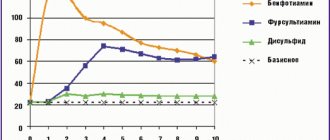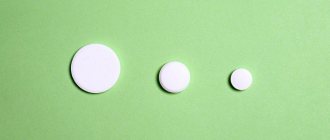Vitamin D and its dosage: more or less?
Vitamin D is perhaps the most “popular” biologically active substance today. Recommendations about its use can be heard both from the media and from doctors in a variety of specialties: from a dentist to an immunologist or endocrinologist, not to mention pediatricians. This “versatility” of vitamin D is associated with the exceptional properties of this substance: cholecalciferol takes part in several dozen biochemical reactions occurring in the body, including vital ones. It is responsible for the normal process of calcium and phosphorus metabolism - accordingly, it plays a role in bone density, teeth strength, and the processes of building and working muscle tissue. Vitamin D is also involved in all parts of the immune system, and with a deficiency of this substance, the body’s defense against both infection and cancer is weakened. This vitamin is also involved in the functioning of the nervous system: it has a beneficial effect on mood, helps prevent cognitive disorders and even Alzheimer's disease. Finally, due to their unique hormone-like structure, cholecalciferol molecules and its metabolites take part in metabolic processes and the production of hormones. And scientists are convinced: all this is not the limit! Probably, the described properties are only part of the unique effects of vitamin D that have been studied, and over time, people will become aware of other possibilities of this substance. But what we already know is enough to say with confidence: every person needs vitamin D for the normal functioning of the body and health in general.
Vitamin D: traditions of taking in different countries
We often ask when taking vitamin D: “What is the optimal dosage?” And this is not an idle question, since cholecalciferol enters our body in three ways at once: with food, vitamin supplements, and is synthesized independently in the skin under the influence of sunlight. Researchers from different countries answer this question differently. For example, in Finland , the country where Minisan® chewable vitamin D tablets originate, there is a whole culture of supplementary intake of cholecalciferol all year round: adults and children 1-2 years of age at least 10 mcg (400 IU) of vitamin D per day, children from 2 up to 17 years old - up to 7.5 mcg (300 IU), and for older people - up to 20 mcg (800 IU) daily! And all this is in addition to a diet rich in cholecalciferol: Finns are supposed to receive the same amount from food, that is, about 10 mcg (400 IU) of vitamin D per day. Why are the recommendations the way they are? Because Finland is a northern country and throughout the year its residents experience a lack of sunlight, and accordingly, the production of “internal” vitamin D in their skin is reduced. At the same time, the Finnish diet is really rich in cholecalciferol - it contains large quantities of fatty fish (including herring and salmon), cod liver, fatty cheeses and dairy products.
table Recommended intakes for vitamin D in Finland*:
| age | dietary intake of vitamin D | Additional need for a vitamin D supplement (in addition to vitamin D obtained from food) |
| Infants: 2 weeks – 12 months | 10 mcg (400 IU)/day | 2-10 mcg (80 -400 IU)/day year round, as recommended by VRN* |
| 1 year | 10 mcg (400 IU)/day | 10 mcg (400 IU)/day all year round |
| 2-17 years | 10 mcg (400 IU)/day | 7.5 mcg (300 IU)/day all year round |
| 18-60 years | 10 mcg (400 IU)/day | 10 mcg (400 IU)/day as needed |
| 61.74 ode | 10 mcg (400 IU)/day | 20 mcg (800 IU)/day all year round |
| >75 years old | 20 mcg (800 IU)/day | 20 mcg (800 IU)/day all year round |
| Pregnant and breastfeeding women | 10 mcg (400 IU)/day | 10 mcg/day all year round |
*Source: VRN (State Dietetic Advisory Council);
Finnish dietary guidelines 2014 and nutritional recommendations for the elderly 2010.
10 mcg = 400 IU Vitamin D.
Also in Europe, there is a clearly defined maximum limit for safe daily intake of vitamin D by the European Food Safety Authority (EFSA).
- for children under one year of age - 25 mcg/day (1000 IU);
- for children aged 1 to 11 years - 50 mcg/day (2000 IU)
- for adolescents over 11 years of age and adults - 100 mcg/day (4000 IU)
The recommendations of US include even higher daily dosages: 600 IU (about 13.5 mcg), 800 IU and even 1000 IU (25 mcg)! And such high doses are justified by numerous clinical studies, the results and conclusions of which are followed by doctors and pharmacists. For example, the American Pharmacists Association (APhA) cites an article by Joan Manson of Harvard Medical School and Shari Bassuk of the Harvard School of Public Health in JAMA2, which states in part: “For vitamin D, 600 IU per day is needed to maintain bone health under the age of 70 and 800 IU per day over the age of 70.” It would seem that the United States is located much further south than Finland: the southern part of the country (about half of the territory) is below the 40th parallel, that is, residents of this area do not experience a deficiency of insolation throughout the year; there is enough sunlight for the synthesis of vitamin D. The population of the northern states only experiences partial deficiency of insolation, mainly in winter. However, doctors recommend taking the vitamin year-round and in high doses. Why? On the one hand, the traditional food of US residents is relatively poor in cholecalciferol. People who deliberately limit animal fats in their diet (and especially followers of a vegetarian diet, of which there are many in America) inevitably deprive the body of vitamin D, which could come from food. On the other hand, with sunlight, not everything is so simple either: the use of sunscreens (of course, justified, as a prevention of early aging and skin cancer pathologies) also has a downside: difficulty in the synthesis of endogenous vitamin D in the skin. There is another factor: an epidemic obesity, which, admittedly, is not yet losing its position in the United States. The body of an overweight person uses significantly more vitamin D on biochemical processes than the body of a slim person. Therefore, doctors recommend replenishing the resulting deficiency of cholecalciferol with additional supplements containing it.
Correct dosage of vitamin D
But what about in Russia , how is it in practice? How much vitamin D does a Russian need, taking into account the geographical features of the country and its culinary traditions? It is impossible to answer this question unequivocally: conditional residents of Sochi and Tyumen, herring lovers and vegetarians, slim people and people with “size”, not to mention their age, may need different dosages of cholecalciferol.
Therefore, we will not provide an average table with recommended dosages for Russia: given its wide geographical location and the fact that the nutritional and lifestyle habits of different people can differ radically, the best solution would be an individual calculation of the optimal dose of vitamin D.
To find out how much vitamin D is needed for adults and how much for children, a blood test should be performed to determine the level of the transport form of this substance, 25(OH)D. By the way, the norm of cholecalciferol is the same for all people, regardless of age and gender. Interpretation of the analysis results according to the current recommendations of the Russian Association of Endocrinologists is presented in the following table:
| State | Level 25 (OH)D |
| Severe hypovitaminosis D | Less than 10 ng/ml |
| Vitamin D deficiency | 11-20 ng/ml |
| Vitamin D deficiency | 21-30 ng/ml |
| Normal Vitamin D Levels | Above 30 ng/ml |
| Hypervitaminosis D | Above 150 ng/ml |
In addition, I would like to say a few words about the exact units in which vitamin D changes. For Russia , the generally accepted dosage is in micrograms (mcg), but in foreign literature the dosage is most often indicated in international units (IU). Converting one value to another is simple: 1 µg of cholecalciferol is equal to 40 IU. Accordingly, 1 IU of vitamin D is equal to 0.025 mcg.
Vitamin D dosage for adults
To prevent vitamin D deficiency, the dosage for adults (from 18 to 50 years old) is at least 200* - 400** IU of cholecalciferol per day - this is one or two Minisan® chewable tablets. Moreover, if the initial level of vitamin D is low, to achieve its adequate concentration in the blood (from 30 ng/ml and above), a course of cholecalciferol at a higher dosage may be required, for example, 800-1000 IU or more per day. Of course, such an appointment should be agreed with a doctor and take place while monitoring the level of 25(OH)D in the blood.
In older and older adults, hypovitaminosis D becomes a common occurrence, so people over 60 years of age are recommended to take at least 600 - 800 IU of vitamin D per day for preventive purposes. This is due to the fact that over the years a person becomes less active, spends less time in the sun, and the intensity of synthesis of endogenous vitamin D in the skin gradually decreases. In addition, in old age, the consumption of foods rich in animal fats decreases, so the resulting deficiency must be compensated for by taking supplements . This is especially important when you consider that in old age, bone tissue begins to actively lose calcium, and taking vitamin D helps to significantly slow down this process. Cholecalciferol also prevents muscle weakness in older people, prevents the development of Alzheimer's disease and age-related weakening of the immune system.
Vitamin D dosage for children
In childhood, when the musculoskeletal system, immune system and the whole body are actively developing, sufficient consumption of cholecalciferol is especially important! For children under one and a half years of age, vitamin D in the form of an aqueous solution is prescribed by a doctor, who also determines the optimal dosage of the substance.
For children over one and a half years old, the optimal form of cholecalciferol is an oil solution, which is convenient to dose in drops and is absorbed as completely as possible by the body. For example, Minisan® vitamin D3 drops. The dosage of the supplement is 2 drops (5 µg (200 IU)) per day for children 1.5-3 years old and 4 drops (10 µg (400 IU)) per day for children over 3 years old.
In case of severe deficiency, the dosage of vitamin D for children can be increased, but such recommendations can only be given by a doctor; you cannot increase the dosage of a vitamin supplement on your own.
Vitamin D dosage for pregnant women
Normally, the level of vitamin D in the blood of an expectant mother should be the same as that of any healthy adult, that is, exceed 30 ng/ml. A sufficient amount of vitamin D in a pregnant woman’s body is an important condition for the health of the woman herself and the proper formation of the fetus. In addition, the results of a number of studies indicate the important role of cholecalciferol in the prevention of complications during childbirth and miscarriage.
For daily preventive use, special multivitamin complexes have been developed for expectant mothers, for example, Minisan® Multivitamin Mom, which also contains vitamin D in a dosage optimal for taking during pregnancy. But I would like to emphasize: if a pregnant woman has a vitamin D deficiency, the dosage of vitamin supplements should be selected by a doctor individually, taking into account the level of 25(OH)D in the blood.
Vitamin D overdose
When determining the optimal dosage of cholecalciferol, a natural question arises: is it possible to overdose on vitamin D? Yes, it is possible if you take vitamins, significantly violating the dosage, for example, 10 tablets instead of one, or a teaspoon instead of two drops, and do this constantly. Unfortunately, these days on various Internet forums and blogs you can find unreliably unsubstantiated advice to take vitamin D in simply huge doses: 2000 and even 5000 IU per day, for long periods of time. With such dosages, “nutraceuticals” and “vitamin specialists” without medical education suggest not only replenishing vitamin D deficiency, but even treating some diseases.
Naturally, most often such experiments on one’s own body end in failure. You need to understand that cholecalciferol supplements should be taken in strict accordance with the dosage recommended by your doctor, and violating it can be dangerous to health.
Another likely cause of overdose is taking active metabolites of calciferol (medicinal) instead of conventional preventive supplements. Active metabolites of vitamin D can only be prescribed by a doctor and require extremely careful administration, in certain doses and in a clearly defined course. (It is worth noting that sometimes even pharmacists in pharmacies do not know the difference between regular vitamin D supplements and its active metabolites, considering such products to be equivalent).
Signs of an overdose may include nausea and vomiting, extreme thirst, increased urination, convulsions, and a sharp drop in blood pressure. If such symptoms appear, it is recommended to consult a doctor immediately.
Finnish vitamins Minisan Vitamin D3: order on apteka.ru!
Vitamin D is a substance that the human body constantly needs, even with regular walks in the sun and eating foods containing cholecalciferol. And no less than the growing child’s body, this vitamin is needed by adults and especially the elderly. Therefore, take care of your health and that of your loved ones: when buying drops for your child, do not forget the pills for yourself and your parents. For example, ordering Finnish Minisan® Vitamin D3 is most convenient here: your order will be delivered to the pharmacy you choose, closer to your home or place of work. For those who are still unsure of the required dosage, we remind you that it is best to do a blood test for the 25(OH)D level and, based on its results, decide together with your doctor how much additional vitamin D you need to take.
Literature:
- Vitamin D deficiency in adults: diagnosis, treatment and prevention. Clinical recommendations. — Russian Association of Endocrinologists. Moscow, 2015
- Manson JE, Bassuk SS Vitamin and Mineral Supplements What Clinicians Need to Know // JAMA. 2018; 319(9):859–860. doi:10.1001/jama.2017.21012.
- Vitamin D for Health: A Global Perspective. — Arash Hossein-nezhad, MD, PhD, and Michael F. Holick, PhD, MD
MAYO CLINIC PROCEEDINGS. November 7, 2013, Vol.88 https://pharmvestnik.ru/content/articles/pitj-ili-ne-pitj-927.html
- VITAMIN D STATUS: MEASUREMENT, INTERPRETATION AND CLINICAL APPLICATION. — Michael F. Holick, Ph.D., MD, Ann Epidemiol. Feb 2009; 19(2): 73–78. https://www.ncbi.nlm.nih.gov/pmc/articles/PMC2665033/
- Vitamin D and metabolism: facts, myths and prejudices - Pleshcheva A.V.*, Pigarova E.A., Dzeranova L.K., - OBESITY AND METABOLISM 2'2012 https://cyberleninka.ru/article/n/vitamin -di-metabolizm-fakty-mify-i-predubezhdeniya
- VITAMIN D: A NEW LOOK AT THE ROLE IN THE BODY, textbook - I.N.ZAKHAROVA, T.E.BOROVIK, T.M.TVOROGOVA, Y.A.DMITRIEVA, S.V.VASILIEV, N.G.ZVONKOVA, - Moscow 2014* according to TR CU 022/2011
* according to TR TS 022/2011
** According to MP 2.3.1.2432-08 Norms of physiological needs for energy and nutrients for various groups of the population of the Russian Federation
VK
Causes of deficiency
When the intake of a vitamin from food or its production by the body is limited, its deficiency develops. Main reasons:
- Prolonged absence from sun exposure
- Going to bed on a glassed-in balcony - ultraviolet radiation does not penetrate through the glass.
- Genetically low ability to absorb cholecalciferol
- Vegetarian diet for a nursing mother
- Prematurity – the baby’s body has not had time to saturate itself with the necessary substances. This process occurs during the last two months of pregnancy.
Symptoms of deficiency
D3 deficiency in children of the first year is fraught with the occurrence of rickets. In our country, the practice of making this diagnosis “by eye” is very common. In fact, rickets is a very rare disease. In developed countries, it occurs in 1 child in 200 thousand. Diagnosis is made based on x-rays and blood tests.
Possible symptoms of rickets:
- Softening and thinning of the skull bones
- Enlargement of the frontal and parietal tubercles
- Late eruption of teeth with poor enamel
- Rachitic rosary - compactions on the bones, on the ribs, for example
- Decreased muscle tone or changes in bone sensitivity
- Growth slowdown
These are just possible symptoms. One cannot draw a conclusion based solely on them. The diagnosis is made only after an X-ray examination of the bones, analyzes of the content of phosphorus, calcium, vitamin D and some hormones.
Symptoms that are not symptoms of rickets:
- Increased sweating
- Frayed hair on the back of the head
- Anxiety
- Moodiness
- Crooked legs
- Hypertonicity
In breastfed children, rickets almost never occurs, because the baby receives the required dose of the substance with mother's milk. Here it is much more important for mom to monitor the amount of sunshine in her body and take care of how to replace the lack of sunshine.
Formula-fed babies used to be at risk, but now almost all formulas contain a sufficient amount of this substance to prevent the development of the disease.
You should consult your pediatrician if you are unsure whether your baby is getting enough vitamin D.
Genetic predisposition to vitamin D absorption
Vitamin D deficiency is sometimes caused by the body's low ability to absorb this substance. It is embedded in our genes and remains unchanged throughout our lives.
There is a genetic analysis that determines how much the body is able to absorb calciferol. Based on a certain genotype, geneticists make a recommendation for taking and additional doses of D3.
Your child should undergo this test if:
- Reduced immunity;
- Frequent food allergies;
- Teeth are cutting with delay;
- There are signs of rickets;
- Fractures or cracks in bones occur for no apparent reason.
Be healthy!









